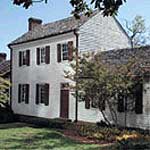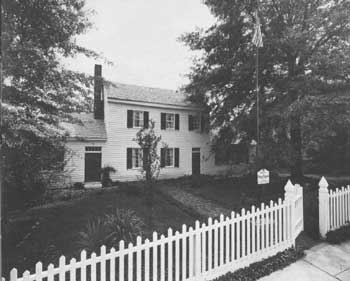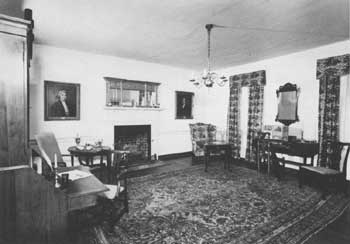







Survey of
Historic Sites and Buildings
 |
BLOUNT MANSION Tennessee |
 Blount Mansion |
| ||
In 1792 William Blount, Governor of Southwest Territory (now Tennessee), built this house, which sits on a slope overlooking the Tennessee River. The capitol of the Territory, the residence be came known as the "Governor's Mansion." Blount had moved to Knoxville early that year, after staying temporarily with William Cobb at Rocky Mount, along the Watauga River, and his family soon joined him. They lived in a nearby log cabin until their home was completed. At the time, it was an imposing structure, the first two-story framehouse in the Territory and one of the first on the trans-Allegheny frontier.
Blount occupied the residence from its completion late in 1792 until his death there in 1800, though in 1797 because of financial difficulties he transferred title to his half-brother Willie. William conducted the business of the Territory, including preparations for statehood, from his office, a separate building on the grounds. Elegant parties were held in the house, which remained the social and political center of the area after statehood was attained in 1796. Among those Blount entertained were Andrew Jackson; John Sevier, Tennessee's first Governor; the French botanist Andre Michaux; Louis Philippe, later King of France; and various Indian chiefs.
 |
| Blount Mansion. (National Park Service (Contractor Bill Tracy, 1975).) |
Blount had chosen the site for his domicile in 1791, not long after he established the capital at White's Fort and named it Knoxville after his friend and superior in the conduct of Indian affairs, Henry Knox, Secretary of War in Washington's Cabinet. Construction was a remarkable feat in view of the difficulty in transporting materials to such a remote wilderness. Finished woodwork, flooring, pine paneling, and exterior weatherboarding were shipped by way of the French Broad and Tennessee Rivers.
Window panes were carried from Virginia by packtrain. Other materials were produced locally; the bricks used in the foundation and chimneys were made at a nearby creek and fired on the site, and heavy timbers were probably sawed at a mill along the creek. The main residence and the outbuildings, including the Governor's office and the kitchen, at the rear of the mansion on its east and west sides, respectively, have been restored and are in excellent condition. The early detached kitchen had been dismantled and rebuilt along the rear of the house. The addition was removed and many of the same materials were used in reconstructing the kitchen on its original foundation.
The gable-roofed residence consists of a two-story, central section, flanked by step-down, one-story wings. The central portion and the west wing were built first; Blount later added the east wing over a daylight basement, to provide more space for his growing family and visitors. Exterior brick chimneys mark the ends of each section. Rectangular transoms top the paneled front door and the separate east-wing entrance. The windows have louvered shutters.
 |
| Parlor of the Blount Mansion. (National Park Service (Tracy, 1975).) |
The formal parlor occupies the east wing. The basement below, which may be reached via a narrow stairway from a trap door in a hail between the parlor and dining room and also by a separate outside entrance, was probably Blount's private office and is now a gift shop. Other rooms include the Pine Room, paneled in the North Carolina pine imported by Blount; and the Green Room, which served as a family room and was used for social functions. The interior features period furnishings and portraits of Blount and other leaders of his day.
In 1925 the Bonny Kate Chapter of the Daughters of the American Revolution and the East Tennessee Historical Society, aided by the city, State, and private individuals, saved the building from destruction. The Blount Mansion Association, which has owned the residence since 1930, has completed its restoration and now administers it as a historic house museum. The Knoxville Garden Club planted and maintains an 18th-century garden on the grounds. The graves of Blount and his wife are 3 blocks to the north in the graveyard of the First Presbyterian Church.
 |
 |
http://www.cr.nps.gov/history/online_books/constitution/site26.htm
Last Updated: 29-Jul-2004